Posts Tagged ‘Modern Art’
Alan Thornhill, British Sculpture, Contemporary Sculpture, Modern Art, Modern Sculpture, Random Sculpture, Raw Sculpture, Spontaneous Art
In Sculpture Personalities, Sculpture Techniques, Sculptures on June 16, 2011 at 8:57 am
Alan Thornhill is a British sculptor who devised his own way of clay-working his sculptural artworks. He creates their composition initially our of course clay parts in a somewhat random selection and does not use the traditional guidance of a wire armature (as do most sculptors). The clay parts are either kiln fired as a whole or cut up and fired individually before re-assembly.
Born in 1921, Thornhill developed his artistic interest from a base knowledge of pottery to a spontaneous development of sculpture. His raw method of sculpting gave room to improvisation. On the other hand his interest in sculpted portraiture challenges the notions of standard and normality. Before his journey into art, Thornhill did several things in his life, including service in the army, and studying up to be a modern historian. In the late 1940’s however, he was accepted into the Camberwood School of Art and studied pottery under Nora Braden. Eventually Thornhill became somewhat frustrated at the repetition involved with creating pottery works. His random nature gave way to the evolution of his interest and he moved to London in 1959 to create his own sculpture studio.
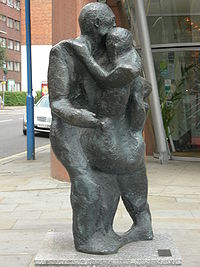
Sculpture by Alan Thornhill, Photography by Magnus Manske
His sculpture; “The Bond” was purchased by the Jerwood Foundation and stands today at Ragley Hall. His daughter; Anna Thornill had also created a 40 minute documentary on him and released it in 2008. The biographical film was entitled “Spirit In Mass : Journey Into Sculpture” and had won an award from Screen South and the UK Film Council.
Abstract Sculpture, Art Appreciation, Collecting sculptures, Large Scale Sculpture, Modern Art, Modern Sculpture, Public Art, Sculptures
In Art Hotspots, Sculpture Techniques, Sculptures on March 11, 2011 at 6:46 am
I thought that with the release of the new Yogi Bear movie, I’d publish this post for a little twist. The Longaberger Company manufactures handcrafted lifestyle products like wooden baskets and fabric products. A perfect symbol of their hard work can be seen even before you enter their building’s lobby floor. Shaped like a huge picnic basket, their headquarters in Newark, Ohio is a prime example of sculptural application in architecture. There are many examples of large-scale sculptures all over the world by commercial or private artists.

I heard that an advertisement for an Adidas football product was done recreating a football field on an elevated billboard. two players would hang by their sides and play a game of football in side-ways gravity. These types of sculptural applications can be very insightful and lend a smile to you daily dose of sights. It’s a good change from the regular ugly paraphernalia of marketing gurus and sales agents. Embodying what you do through the craft of sculpture is really admirable and a good contribution to the creative influence of others.
When sculpture intertwines with everyday life, that’s when it’s most appreciated. Sculptors and artists take pride in what they do, and what better fulfillment than having people use and live in your artworks. These days, the bar is set higher and higher for creative innovation. Where will our ideas take us in ten or twenty years? I propose holographic sculptures.
Abstract Sculpture, Art Appreciation, fiberglass sculpture, John Buckley, Modern Art, Modern Sculpture, Sculpture, The Headington Shark
In Sculpture Personalities, Sculptures on March 11, 2011 at 6:32 am
Well this isn’t something you see everyday, even if you’re a scuba diver. The Headington shark is a sculpture that was made to symbolize the reaction to the attrocities commited at Nagasaki. It’s suppose to be likened to the nuclear power used against innocent people when bombs were dropped from the sky. The sculpture is about two hundred kilograms and is made of fiberglass. In 2007, it was renovated by the sculptor who built it.

Sculpture bu John Buckler – Photography by Henry Flower
Sometimes contemporary sculpture need not neccessarilly be appealing in the sense of visual beauty, but the depth of meaning behind the artwork must stand out one way or another. The Headington Shark is a perfect example of contemporary art that makes you wonder what on earth the artist was thinking. It draws you in to discover the history of its inspiration and story. John Buckley; it’s creator, was a genius when he created such a bold, yet curious piece. The shark wasn’t always appreciated though. A long time ago, the Oxford City Council tried to have it removed and relocated to a local swimming pool, but the people had grown too much attachment to the sculpture that it ended up staying right where it was.
Abstract Sculpture, Art Appreciation, land art, living sculpture, Modern Art, Modern Sculpture, novelty media, Public Art, Sculpture, Sculpture Methodologies
In sculpture movements, Sculpture Techniques on March 11, 2011 at 6:04 am
We’ve all seen the recent green movement rise up in popularity over the past few years. It’s affected almost every industry including the arts to a great extent. One particular movement that we’d like to tackle today is the issue of “living sculpture”. I bet you’ve seen those large gardens often spotted amidst locations of royalty or government. These are the ones laden with sculpted trees and shrubs (a good example could be the garden maze that we always see on television and movies.) These are examples of living sculptures, or so people say. Landscape architects and designers argue that this movement is merely an extension of their own profession.
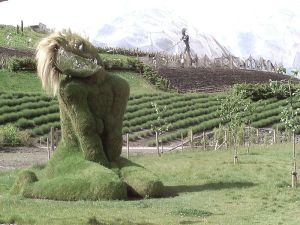
As far as we know, there are a few categories that belong to the movement of living sculpture, some that intercross with landscape design as well. First off, we have Topiary art. This is a more common sight and it engulfs the examples I gave earlier. Topiary art can usually be made by creating shapes or forms from living plants. Select pruning and contour restriction training are some of the techniques of this art. Bonsai is also a product of this discipline that portrays miniature trees as artworks in landscape. Creatively cutting crop areas also qualifies as the creation of living sculpture. Turf or sod-work on the other hand, is a more recent development that has stemmed out of the Land-Art movement of sculpture. They were seen as a way for art to be a direct part of nature and landscape, and were often temporary and large-scale.
Today, there are many that can differentiate living art from landscape design, and there are also those who believe that the two are one and the same. What do you classify as living art?
Abstract Expressionism, Art Appreciation, Collecting sculptures, Modern Art, Modern Sculpture, Peter Reginato, Sculpture Methodologies, Sculptures, Steel Sculpture
In Sculpture Personalities, Sculpture Techniques on March 1, 2011 at 1:36 am
Abstract sculptor Peter Reginato is famous for putting the randomness of abstract expressionism into his many multi-dimension works. He began his journey into abstract sculpture in the 1960’s and moved to New York from his stay at the San Fransisco Art Institute. His devotion and time spent with the craft landed him the opportunity to be invited to several group shows in prestigous places like the Park Place Gallery in NY. Later on in his career, Reginato was represented by the Tibor de Nagy Gallery.

Little Mo Sculpture by Peter Reginato, Photography by the artist (2006)
His bold sculptures deeply resemble the paintings of abstraction that spread out in a burst of contours and color. For one to create a 3D version of that effect is a task that Reginato had spent several years to perfect. Reginato’s works contained shaped elements ranging from spirals to springs and blobs to figures. His diversity in composition was utterly astounding with every individual work.
Reginato had a two man partner show entitled “Color-Coded” with Ronnie Landfield in 2005 at the Heidi Cho Gallery in Chelsea. In 2007 though he had is own one-man show at the same gallery. The sculpture exhibition was comprised of his welded stainless steel sculptures and was entitled “Low Maintenance” maybe because these works were unpainted and left bare in their natural metallic state. Reginato’s passion for the steel collages is a deeply admirable one. His hobby turned into his career and he is one of the lucky people in the world that loves what he does.
Abstract Sculpture, Art Appreciation, David Smith, Modern Art, Modern Sculpture, novelty media, Public Art, Steel Sculpture
In Sculpture Personalities, Sculpture Techniques on March 1, 2011 at 1:19 am
American sculptor David Smith created over 28 fascinating stainless steel sculptures entitled “Cubi”. These pieces, though part of a whole series, are all originally insightful on their own. Seemingly derived from cubism in painting, these notable rigid artworks are a feat of balance, proportion and artistic mastery. Unfortunately, Smith died from a car accident in 1965 after completing the 28th sculpture, there may have been more that he intended to create.
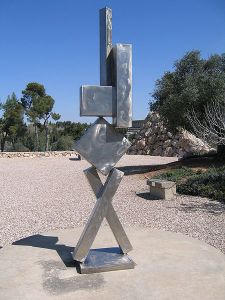 Cubi VI, sculpture by David Smith (1963)
Cubi VI, sculpture by David Smith (1963)
The 28th work, Cubi XXVIII was finished that year as well (1965) and was the most expensive artwork ever sold in the category of contemporary art at Sotheby’s New York auction house. The piece sold for 23.8 million dollars to billionaire art collector Eli Broad.
Cubi was an intuitive series that deeply extended the mastery of steel sculpture that Smith had already obtained during his many years at the practice. Some of his other Cubi sculptures made their way into internationally acclaimed museums as well, like Cubi VII went to the Art Institute of Chicago, and another work went to the Hirshhorm Museum. The legacy left behind by Smith casts a shadow on all other steel welding sculptors if they should hope to accomplish the greatness that he has through his monumental pieces.
Abstract Sculpture, Art Appreciation, Clement Meadmore, Contemporary Sculpture, Mixed Media, Modern Art, Modern Sculpture, novelty media, Public Art, Sculpture Methodologies, Steel Sculpture
In Sculpture Personalities, Sculpture Techniques on March 1, 2011 at 1:04 am
Hailing from Melbourne, Australia, Meadmore was a someone who came into sculpture from a designer’s background. He had studied aeronautical engineering and industrial design at the Royal Melbourne Institute of Technology, after which he tried his hand at creating furniture designs for over five years before creating hi first welded sculpture in the late 1950’s. Meadmore exhibited mainly around his local area and Sydney during around the same period of time. He moved to New York though some years after he had started exhibiting his sculptures.

Curl, 1968 By Clement Meadmore
He specialized in steel structures that were larger than your average decorative art sculptures, but was able to maintain a sense of fluidity and aesthetic sensibility in most of his creations. He used steel, aluminum and bronze to fashion large outdoor pieces of minimalism and abstract expressionism. Many 0f his works revolved around the theme of music, particularly jazz since he was also an avid amateur drummer and jazz fan. Aside from his sculptures being collected privately and publicly, Meadmore was also the author of popular design books How to Make Furniture Without Tools and The Modern Chair: Classic Designs by Thonet, Breuer, Le Corbusier, Eames and Others. The designer part of him still yearned for industrial creation all through his artistic years in the business.
Meadmore’s unique style can be observed in many public locations such as the Newport Harbor Museum in Newport Beach, Figge Art Museum in Davenport, Johnson County Community College in Overland Park, and many others places.
Art Appreciation, International art, Modern Art, novelty media, Sculpture Collection, sculpture museum, wax museum, wax sculpture
In Art Hotspots, Sculpture Techniques on March 1, 2011 at 12:42 am
Collecting sculptures can be a very rewarding experience, but sometimes its just as enjoyable to take a trip down to your local museum and bask in the art. For europeans, the wax museum is often a good place to observe a different sort of sculpture style.
Wax museums started with the travels and collections of Marie Tussaud, who lived in the eighteenth century, but is now the most popular name in the business of wax sculpture museums. The original Tussaud set up her first show in the 1830’s on Baker Street in London. Today, her establishments can be found all over the world, some more famous locations are the fixed ones in Dam Square – Amsterdam, Hong Kong, Shanghai and the one in Times Square – New York.
The Movieland Wax museum in Buena Park, California was also a big hit with the tourists that come to see these lifesize replicas of famous people and scenes in human history. Though that particular museum had to close its doors in 2005 after over forty years of service.
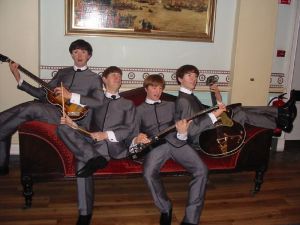 Beatles Wax Sculpture Replicas – Photography by Lasse Havelund
Beatles Wax Sculpture Replicas – Photography by Lasse Havelund
The Hollywood wax museum in California is another famous location where movie actors can be seen as surprisingly accurate wax sculptures. The Musee Conti Wax Museum in Lousiana has its own Haunted Dungeon of wax cast figures sure to terrify any crowd.
These are just some of your more popularized destinations to go for wax sculptures, but the trend is pretty spread out all over the globe. It’s a change from the regular art auction or gallery exhibit, because you get to see something new. Wax sculptures are usually done in a style of realism that can be very detailed and accurate when compared to the actual model. In time, I’m not surprised if many more museums will make use of new was casting methods to display their collections in almost-real scenarios.
Art Appreciation, International art, Mixed Media, Modern Art, novelty media, Sand Sculpture, Sculpture, Sculpture Competition, Sculpture Methodologies
In Art Hotspots, Sculpture Techniques on March 1, 2011 at 12:21 am
Around the world, sand festivals are growing in popularity. Sometimes called Sand Sculpture Festivals because of the main attraction involved, thousands of people gather to witness both the making of monumentally scaled sand artwork, and the exhibit of diverse compositions one would never see at a regular gallery. These festivals showcase the talent and flexibility of sculptors while testing their mastery. Working with sand as a medium is often difficult because of its grainy tendency to crumble down. During the Sand Sculpting Australia “Dinostory” Festival, sculptors were excited to sculpt their favorite prehistoric subjects out of raw beach sand. The Australian Festival is a yearly event that is held at Frankston, Victoria since 2008.
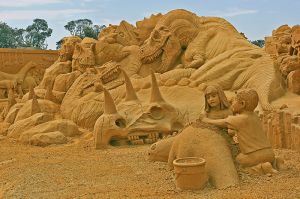
Sand Sculpture – Photography by John O’ Neill
Other countries that encourage this type of sculptural activity include Canada (Lau Beauchamp Park and Clam Harbor in Nova Scotia), Germany (Berlin’s Sandsation Festival) and India (Goa Sand Festival) among others. Many subjects that are sculpted in sand are drawn directly from themes given during the competition, however some artits, like Patnaik in India, prefer to sculpt artwork in support for a specific cause like the tsunami strike in Puri.
The most widespread sand sculpting festival in Portugal; the International Sand Sculpture Festival was the largest of its kind anywhere in the world. It has been held in Algarve since 2003. Russia also contributes to the worldwide phenomena of sand sculpting, with its recent 2005 sand show; “Animal World” which was held at the Moscow Zoo. To much of everybody’s surprise, the venue and inspirational surroundings gave the artists exactly what they needed to put up one heck of a show. Sand sculpting around the world has been the recent dream of many artists and even some regular beach-hoppers. It’s a fun and recreational practice that encourages creativity in today’s fast-paced society.
Confesional Art, Louise Bourgeois, Modern Art, Modern Sculpture, Sculpture, Sculpture Methodologies, Sculptures
In Sculpture Personalities, Sculpture Techniques on February 26, 2011 at 7:29 am
A French American Sculptor, Louise was also nicknamed the “Spiderwoman” for her spider-like sculptures that she entitled Manman. Louise’s are focuses mainly on the themes of humsn expression, i.e. loneliness, anxiety, betrayal. She considered her abstract works to be narratives of emotion and wanted them to convey some sort of human condition that language alone could not fully communicate.

Despite her introvert-personality as a child and her hatred for her father, She managed to gain strength as an artist and studied t several prestigious schools to hone her craft. Such schools included the Académie de la Grande Chaumière in Paris and the École des Beaux-Arts. Learning from many great masters in the world of sculpture, she slowly developed her very own mannerism and techniques. She also eventually taught art at the Pratt Institute and the New York Studio School of Drawing, Painting and Sculpture.
Her Sculpture, Manman is one of the famous spider structures she had set up. She began to create these tall, spiny-legged abstractions in the late 1990’s and incorporated the spider subject as a core element in her work. Manman stands to be over nine meters tall and is made up of steel and marble. Eventually more were made, but not using the same material. Louise mentioned that the spider, being a clever weaver, was an ode to her late mother who was in charge of their tapestry business. It also reminded her about how her mother used to protect them from harmful externals, the way spiders eat pest insects.





 Cubi VI, sculpture by David Smith (1963)
Cubi VI, sculpture by David Smith (1963)
 Beatles Wax Sculpture Replicas – Photography by Lasse Havelund
Beatles Wax Sculpture Replicas – Photography by Lasse Havelund
